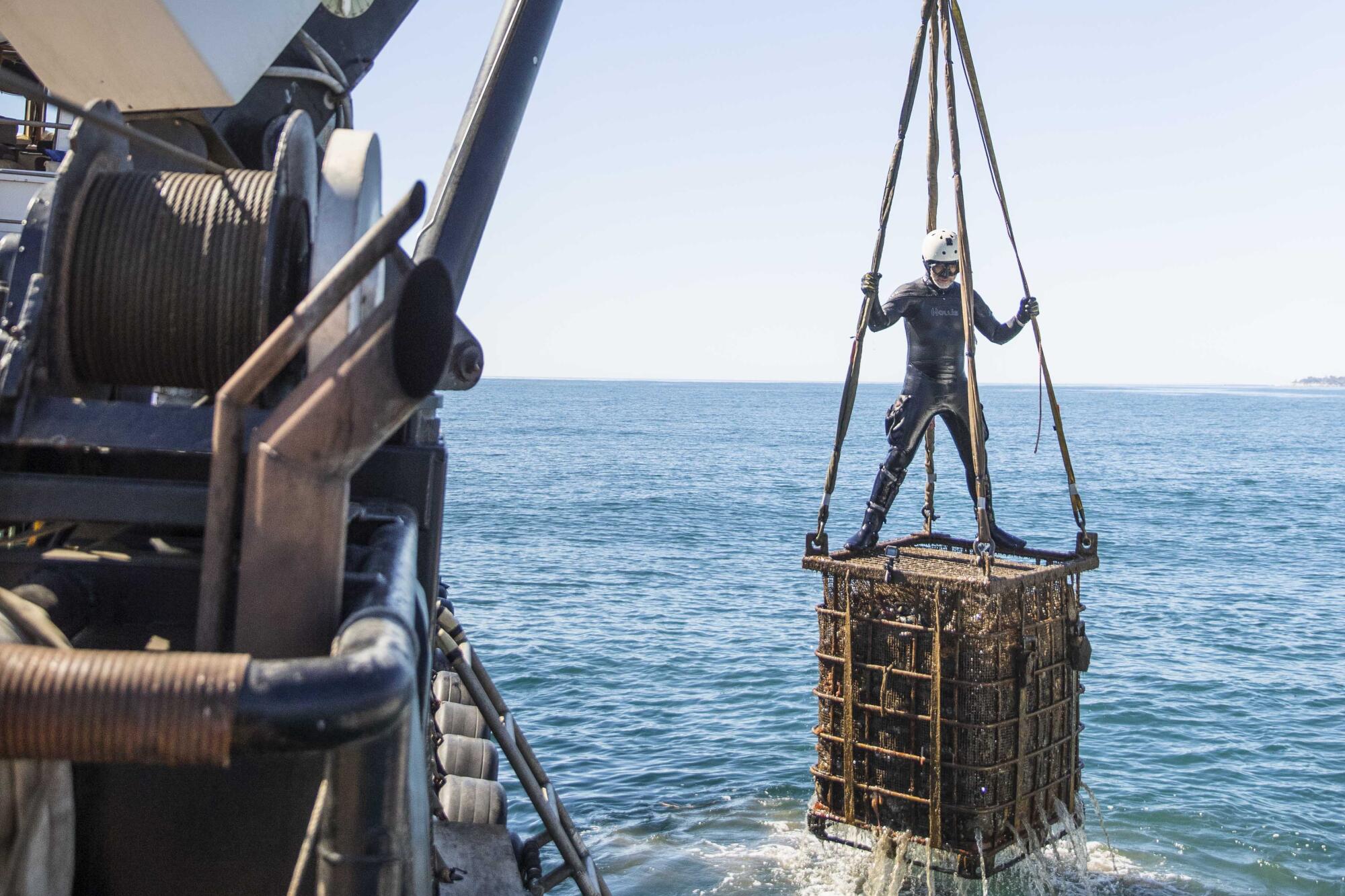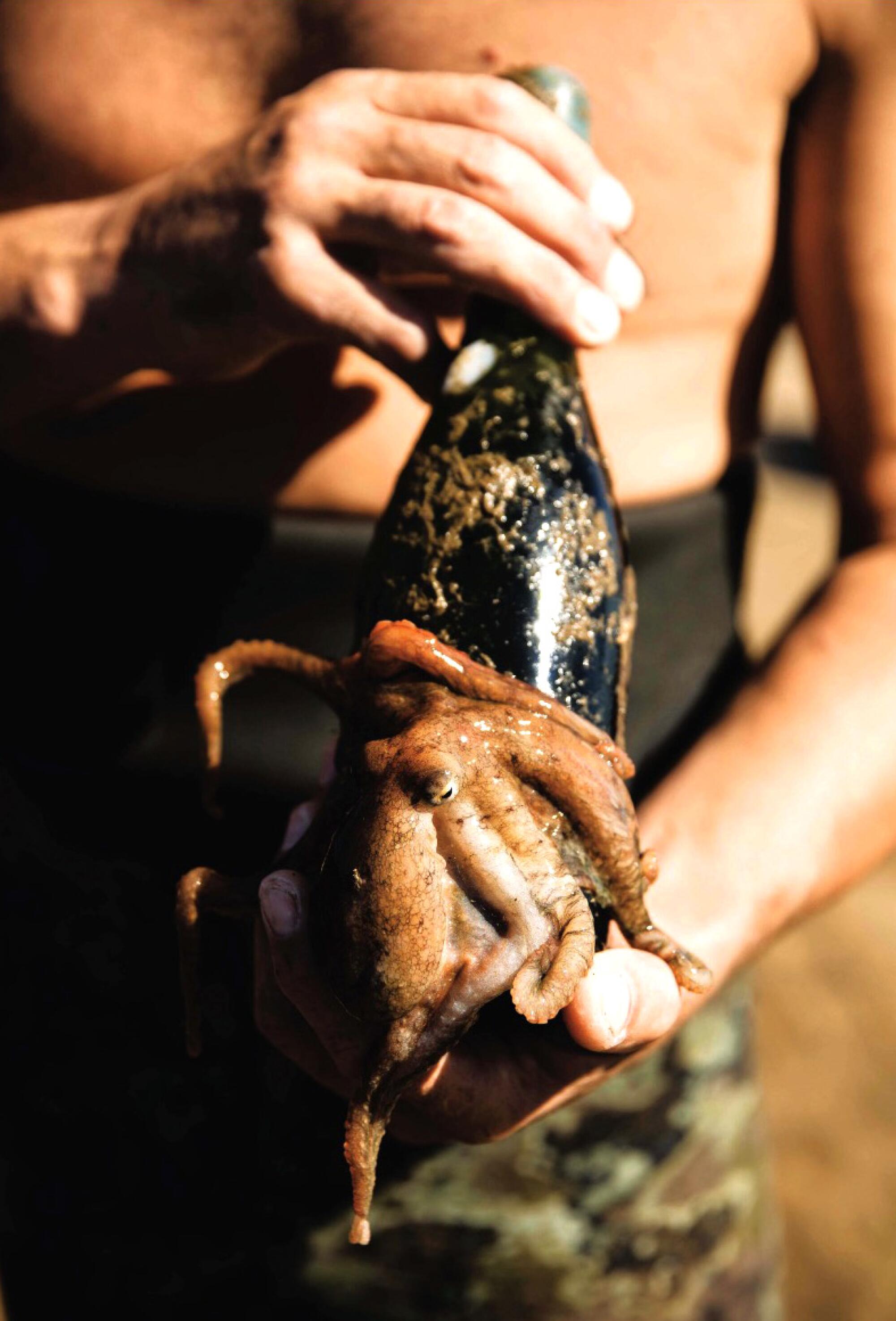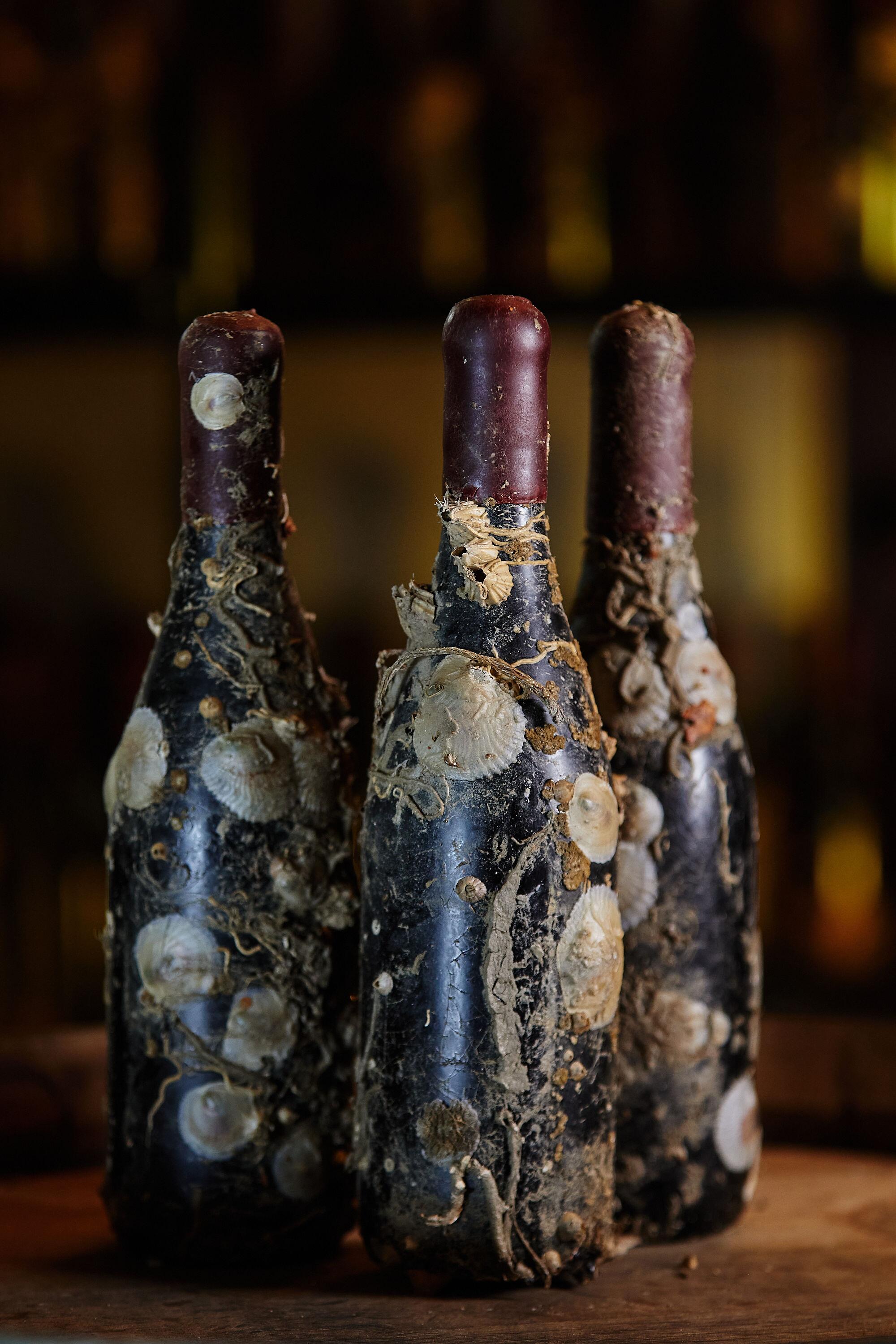
Even in a state known for wine innovation and a willingness to embrace new fads, it was a quirky idea: aging bottles of wine at the bottom of the ocean, about a mile off Santa Barbara.
But that is exactly what the four founders of Ocean Fathoms were doing. The company filled iron cages the size of washing machines with wines that sell in the $70 to $200 range, and lowered the bottles into the Pacific to a depth of about 70 feet. A year later, this ‚Äútruly remarkable‚ÄĚ wine, transformed by the ‚Äúpatented ocean aging process,‚ÄĚ as the company‚Äôs marketing pitch says, was pulled up from the ‚Äúsea cellar,‚ÄĚ and one of the owners told me the going rate was $350 a bottle.
Or at least that is what they were doing until the California Coastal Commission got wind of the business.
The basic idea is that storage in a place without oxygen or light, at a perfect temperature with a gentle swaying motion and a ‚Äúgalvanic current,‚ÄĚ can improve wine dramatically. But the jury is out on whether this process makes the wine any better or is little more than a marketing gimmick.

Still, Ocean Fathoms anticipated a solid market, partly because of how the product looked after coming out of the deep. ‚ÄúThe bottle is our most significant point of differentiation,‚ÄĚ the company‚Äôs website says. ‚ÄúIt drives consumer engagement and attention like no other brand on the market.‚ÄĚ
And here’s how:
‚ÄúThe sea life that attaches to our bottle is the ultimate in nature‚Äôs packaging. Each bottle is adorned with barnacles, coral, seashells and ornate hard shelled tubes formed by annelida sea worms.‚ÄĚ
Of course, last I checked, ‚Äúsea life‚ÄĚ does not continue living when it‚Äôs plucked out of the sea.
‚ÄúFor those of us who work in ocean and coastal protection, the sight of a wine bottle encrusted with dead marine life is not a plus,‚ÄĚ said Susan Jordan of the California Coastal Protection Network, adding that the caged wine has been stored in a designated kelp harvesting area.
In the marketing photos on the Ocean Fathoms website, a baby octopus is wrapped around a bottle of Sangiovese and another is attached to a white blend. It’s not clear whether either sea creature is still alive, although Ocean Fathoms’ owner and president, Emanuele Azzaretto, said that any live octopi are tossed back into the water. He also said a portion of the profits are donated to the Channel Islands Marine and Wildlife Institute, an ocean conservation nonprofit.
This enterprise was proceeding swimmingly until several months ago, when the California Coastal Commission began reviewing a permit application from Ocean Fathoms. The owners had started experimenting with underwater storage years before applying to legally do so, which didn’t sit well with the state agency. Commission staff took a deep dive on the operation, found it in clear violation of the Coastal Act in several ways, and issued a stern warning to the company in February.
In effect, the agency said: The ocean is not your private wine locker, guys. So get the wine out of the water or face fines that could run in the tens of thousands of dollars.
Ocean Fathoms brought up the wine but hasn’t given up the fight. Back in March, just after the company was put on notice, it hosted a $1,000-per-person excursion to the sea cellar aboard a yacht, where passengers were treated to a wine tasting after the dripping cages were raised like a sunken treasure.

Ocean Fathoms‚Äô four founders are described on the website as ‚Äúan eccentric Italian diver, a California surfer obsessed with brand building, a handsome Frenchman with an impressive wine and hospitality pedigree and a multi-award winning English/American/Indian winemaker.‚ÄĚ
I recommend opening a bottle of wine before watching the website’s videos at oceanfathoms.com, and you won’t need to supply your own cheese. There’s plenty of it in the company’s atmospheric, slow motion cinematography set to music as the crew embarks on a voyage to sink cages of wine.
Think Jacques Cousteau meets the Pirates of Pinot Noir.
But these guys are serious, and they’re not about to walk the plank just because the Coastal Commission picked a nit or two.
‚ÄúI did everything up front,‚ÄĚ Azzaretto said. ‚ÄúI called the Coast Guard, I called and waved flags, I went to Fish and Wildlife and knocked on every door, and nobody knew where to send us.‚ÄĚ
Azzaretto said he bought a boat and a commercial fishing license, and thought the wine plunge would be legal because it was similar enough to the work of crabbers, who drop cages into the water and pull them back up. But then the Army Corps of Engineers, which has some regulatory authority over structures and operations in harbor areas, became aware of the wine storage last August and alerted the Coastal Commission.
A Coastal Commission hearing on the matter, scheduled for earlier this month, was postponed. Azzaretto told me Ocean Fathoms is still putting together a response disputing the commission’s findings, and he seemed optimistic an agreement could be reached. He sent me letters of support from Santa Barbara County Supervisor Das Williams and from Mike Lopez, vice chair of the Santa Ynez Band of Chumash Indians.
Azzaretto said he’s hopeful that at full production, the company will store 30,000 to 50,000 bottles of wine underwater each year. But the report from the Coastal Commission staff, in recommending against a permit, explained how that would violate the Coastal Act.
According to the report, ‚Äúa seafloor wine storage facility has the potential to result in adverse impacts to commercial and recreational fishing‚ÄĚ and would ‚Äúadversely affect marine biological resources by disturbing, crushing and smothering marine life within the facility‚Äôs installation footprint, altering the seafloor habitat ... and ... trapping and entangling fish and mobile marine invertebrates.‚ÄĚ
In a letter of response, Azzaretto disagreed. He said the wine storage system is designed to have ‚Äúno environmental impacts,‚ÄĚ adding that it will enhance the robust Central Coast wine industry. He also argued that the practice constitutes a form of aquaculture, which is allowed under the Coastal Act.
But the commission wasn‚Äôt buying that last argument. Aquaculture, it responded, is a ‚Äúform of agriculture devoted to the propagation, cultivation, maintenance and harvesting of aquatic plants and animals in marine, brackish and fresh water. Wine is not an aquatic plant or animal and thus, the proposed project does not fit the definition of aquaculture.‚ÄĚ
Aging bottles of wine at the bottom of the ocean, about a mile off Santa Barbara.
As Azzaretto told me, his company is not the first to store wine on the ocean floor. There are sea cellars in Greece, Italy, Spain and Chile, some of them inspired by stories about great-tasting wines found during discoveries of decades-old sunken ships. Azzaretto told me the company is partnering with several winemakers and storing their wine underwater, then splitting the profits.
Skeptics abound.
‚ÄúThis is marketing,‚ÄĚ said Andrew Waterhouse, professor of viticulture and enology at UC Davis. ‚ÄúThe technical description is voodoo (with apologies to Haiti). ... It‚Äôs a way to make a very scarce product that rich people can buy and brag about. As you can see, I‚Äôm not sold on this.‚ÄĚ
Neither is John Tilson, founder of the Montecito, Calif.-based Underground Wine Letter. His online magazine was established, Tilson noted, to deliver the honest truth about the food and wine industries, rather than the puffery often found in more commercial publications.
‚ÄúIn a word,‚ÄĚ Tilson said after reviewing the Ocean Fathoms claims about its wine storage process, ‚Äúit‚Äôs b‚ÄĒ.‚ÄĚ
He went on to repeat the word, unprintable in a family newspaper, several times, a bit more emphatically each time. Traditional wine storage has done the trick for hundreds of years, Tilson said, and there’s no reason to drop bottles into the ocean other than to charge more for them.

Three highly regarded California winemakers each told me they were curious but skeptical. Two of them noted with interest, however, that one of the four partners at Ocean Fathoms is Rajat Parr.
Parr is an acclaimed sommelier and winemaker who has worked at some of the most exclusive restaurants in California. His Central Coast wineries include Domaine de la Cote and Sandhi, which produce fine chardonnays and pinot noirs.
Parr told me he was skeptical when the others first approached him with their business proposition, but then he tasted the sea cellar wine in a controlled comparison against wine that hadn‚Äôt been underwater. He was so impressed, he decided to store some of his own wine in the cages ‚ÄĒ a 2016 Domaine de la Cote Memorius Pinot Noir, and a 2014 Sandhi Bentrock Chardonnay. Each retails for about $70 without the plunge.
‚ÄúI can guarantee you one thing,‚ÄĚ said Parr, who told me that when his submerged wine was brought up and corked open, it was sensational. ‚ÄúAnybody ‚ÄĒ anybody ‚ÄĒ who tastes the bottle that had been aged under the ocean versus the bottle aged in a regular cellar will tell the difference, no doubt.‚ÄĚ
Parr said the wine’s aging is not accelerated, as his partners have suggested in their marketing (one of the owners says in a video that the wine ages 10 years in one year under the sea). Parr said he asked them to clarify that point, because in his opinion the wine is enhanced rather than rapidly aged, with noticeable differences in the texture.
The tannins in red wines are ‚Äúsuper soft,‚ÄĚ Parr said, and ‚Äúthe whites are creamier.‚ÄĚ
‚ÄúA lot of this is certainly experimental and I don‚Äôt think any of us are saying ... this is the future,‚ÄĚ Parr said. ‚ÄúWe‚Äôre kind of in the early phase of trying to figure it out.‚ÄĚ
But to Jennifer Savage, California policy manager for the Surfrider Foundation, the question of whether wine stored on the ocean floor tastes better is beside the point.
‚ÄúThe ocean is a shared playground for humans and an incredible home for all kinds of sea life,‚ÄĚ Savage said. ‚ÄúIt‚Äôs not a private industry space for unpermitted exploitation.‚ÄĚ
More to Read
Sign up for Essential California
The most important California stories and recommendations in your inbox every morning.
You may occasionally receive promotional content from the Los Angeles Times.











